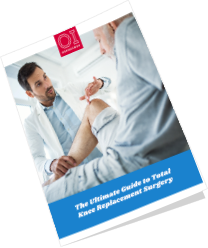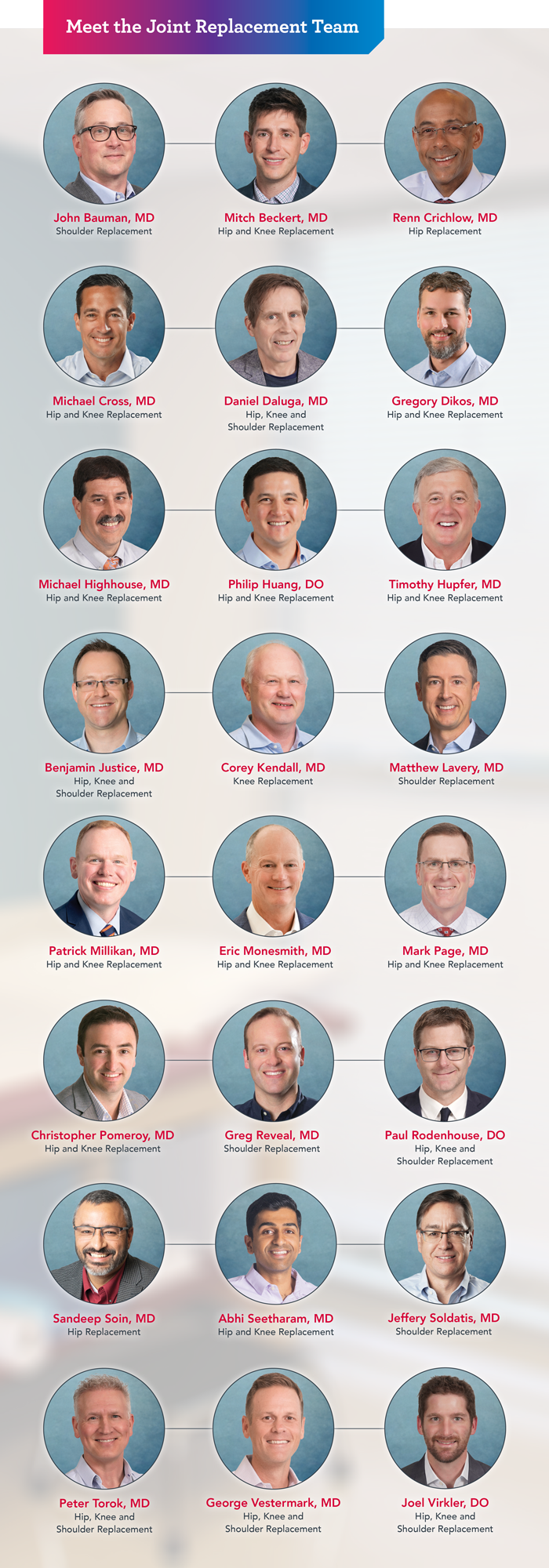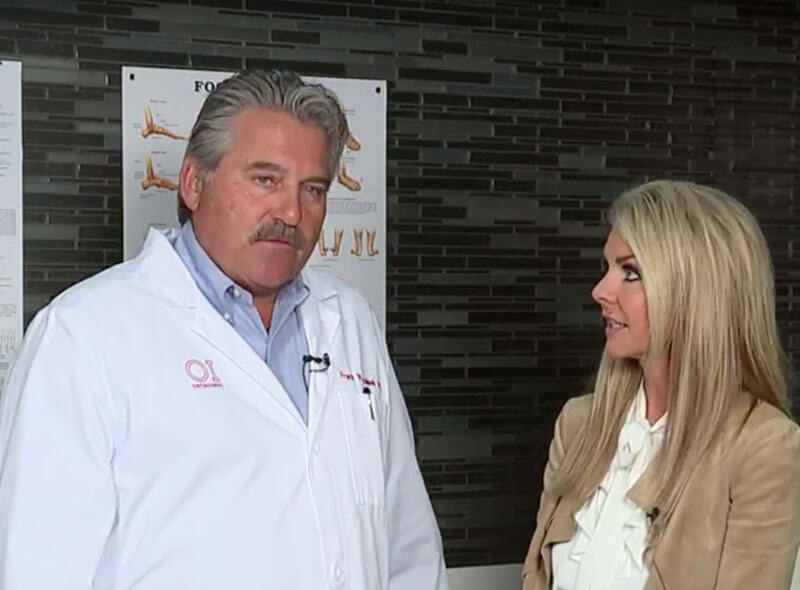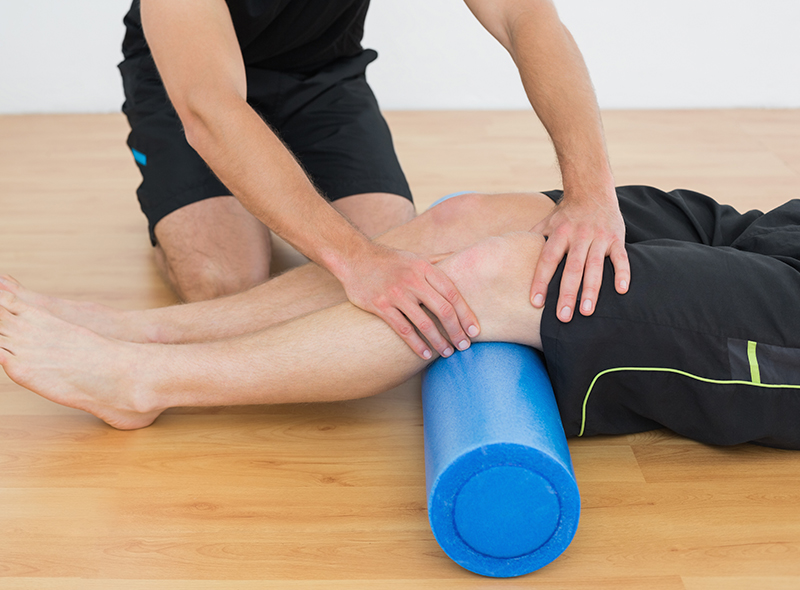The ultimate guide to
Total Knee Replacement Surgery
Understand what your knee pain means, what might be causing it, when it might be time for a knee replacement surgery and how a total knee replacement can bring you relief.

This guide discusses ...
Living with knee pain is not normal
Knee arthritis isn’t new, nor is a knee replacement as a way to treat its associated pain and inflammation.
As far back as the 19th century, surgeons began attempting to reconstruct the damaged surfaces of arthritic knees.
We’ve come a long way since then, and today things are different.
Total knee replacement surgery is safe, reliable and durable. It is one of the most effective—and one of the most common—operations of any type developed during the 20th century.
Modern knee replacement procedure involves replacing the diseased portions of a knee joint (the damaged cartilage and part of the bone underneath) with a replacement prosthesis to relieve your pain and make your joint work better.
New joints usually last at least 20 years for around 80 to 90 percent of patients who have a total joint replacement procedure to relieve the pain from knee arthritis.
OrthoIndy’s Ultimate Guide to Total Knee Replacement Surgery will help you better understand what your knee pain means, your problem, what might be causing it and how a total knee replacement can bring you relief.
Whether you’re just beginning to research knee arthritis or if you’ve already decided to have total knee replacement surgery, this guide includes a number of resources from our team of experts that you’ll find helpful.
1 What causes knee pain, and how can I find relief?
Every time you take a step, you use your knee, and it’s this use that makes your knee susceptible to a number of injuries.
According to the American Academy of Orthopaedic Surgeons, knee injuries are the most common reason why people schedule a visit with an orthopedic surgeon.
But, there are differences between temporary knee pain that is typically caused by an injury or accident, and chronic knee pain that is often caused by knee arthritis.
What is knee arthritis?
Arthritis is the medical term for inflammation of one or more of your joints, and it is especially common in the knee.
There are more than 100 different forms of arthritis that can affect a variety of joints in your body, and most knee pain is caused by one of these three kinds of arthritis:
-
- Osteoarthritis. Osteoarthritis is the most common form of arthritis in the knee. It is a degenerative, wear-and-tear type of arthritis where the cartilage in the knee joint gradually wears away. As a result of this lack of cartilage, bone rubs on bone, often producing bone spurs, or bony growths that tend to develop on the edges where your bones meet each other in a joint.
Osteoarthritis develops slowly, and the pain increases over time.
-
- Rheumatoid arthritis. Rheumatoid arthritis is a chronic disease that can attack multiple joints throughout your body. It can affect the same joint on both sides of the body.
Rheumatoid arthritis is an autoimmune disease. This means the immune system attacks your body’s own tissues and damages the cartilage and ligaments while softening the bone. When you have knee pain and stiffness due to rheumatoid arthritis, it’s because the synovial membrane that covers your knee joint is swollen.
- Post-traumatic arthritis. Post-traumatic arthritis is a form of arthritis that develops after an injury to your knee, such as a broken bone, meniscal tear or ligament injury. These kinds of injuries can cause instability and additional wear of your knee joint that over time can lead to arthritis.

Is total knee replacement my only option?
If nonsurgical treatment options for your knee arthritis symptoms fail to provide pain relief, your doctor may recommend a type of knee surgery based on your arthritis and symptoms.
Some potential surgical options include:
- Arthroscopy.Arthroscopy is when a small incision is made to treat joint problems. Not especially common, this procedure is primarily used when arthritis is accompanied by a degenerative meniscal tear.
- Osteotomy. An osteotomy is a procedure when either the tibia or femur is cut and then reshaped to relieve pressure on the knee joint. It is used when you have early-stage osteoarthritis that has only damaged one side of the knee, and it is used only for young, very active patients.
- Total, or partial, knee replacement. In a total or partial knee replacement procedure, a physician will remove your damaged cartilage and bone and replace it with new metal or plastic joint surfaces. This type of surgery is highly successful and is one of the best options for treating arthritis. Advances in technology have made this procedure much safer and more reliable, and recovery has become much easier for patients.
When is total knee replacement surgery the best choice?
In most cases, your doctor will only recommend surgery once you’ve gone through all non-operative treatment options and you haven’t noticed any significant or lasting improvement.
Deciding to have a total knee replacement often has to do with your pain levels, amount of disability, the length of time you’ve been in pain and what treatments you’ve already tried.
Elective total joint replacement surgery is always your choice. But, some knee pain problems will only get better with surgery. Your total joint specialist will work with you to make sure you make an informed and educated decision.
Many patients find undergoing total knee replacement surgery is beneficial because it helps them get back to an active life, and putting off surgery sometimes means putting off getting back to your normal life.
READ ARTICLE: HOW TO TELL YOUR LOVED ONE TO SEE A DOCTOR FOR JOINT PAIN
How can I manage my pain without surgery?
Even though researchers have yet to find a cure for knee arthritis, there are a number of ways you can relieve your pain and stiffness non-surgically.
As part of a conservative treatment plan, your doctor may advise you to try to:
- Minimize your activity by switching from high-impact activity to low-impact activity
- Work on losing weight to decrease the force on your knee, if overweight
- Get help from a physical therapist
- Use assistive devices, such as canes and shoe inserts
- Take medication, such as NSAIDs (non-steroidal anti-inflammatories) like ibuprofen (Tylenol can also be effective)
- Get corticosteroid (cortisone) injections
OrthoIndy total joint surgeon, Dr. Frank Kolisek discusses knee replacement surgery to treat arthritis.

2 Do I need knee replacement?
Your knee is a major weight-bearing joint, and it is held together by muscles and ligaments that allow your leg to bend and straighten so that you can walk and climb stairs.
When your knee is arthritic, the cartilage wears away, causing the bones to grind together. This produces pain, loss of motion and swelling.
Knee replacement at OrthoIndy
OrthoIndy total joint replacement surgeons specialize in replacing a joint damaged by trauma or arthritis with an artificial joint. Let us help you fix what hurts.
Is it time to consider knee replacement surgery?
Knee arthritis can be extremely uncomfortable and easily affect your quality of life.
If your knee is causing you pain when you are simply walking to your car, doing some gardening or even sitting or lying down, knee replacement may be an option to provide knee pain relief.
READ ARTICLE: SIGNS YOU MAY NEED KNEE REPLACEMENT
About diagnosis
To make a diagnosis, your doctor will conduct a physical examination and ask you for a complete medical history and description of your symptoms. An X-ray or MRI may be necessary for confirmation and to determine if there are other problems.
What are signs that I might have knee arthritis?
Meet with a physician to determine whether you have knee arthritis and symptoms of needing knee replacement. Some symptoms of having knee arthritis include:
- A painful and inflamed knee
- Pain that develops gradually over time
- Stiffness in your knee joint that makes it difficult to bend and straighten your knee
- Activity is followed by pain in your knee joint
- Your knee locks or sticks during movement
- Your knee creaks, clicks, grinds or snaps
- A feeling of weakness or buckling in your knee
3 What is total joint replacement surgery, and does it work?
Joint replacement surgery is a procedure in which a surgeon removes the arthritic areas of your joint and then caps the bone ends with man-made implants. If your OrthoIndy specialist recommends total joint surgery, OrthoIndy Hospital has been a Five-Star Recipient for Total Knee Replacement from 2008 to 2019.
Obesity and total joint replacement
If you are obese with a body mass index (BMI) higher than 39, your risk of complications during and after total joint replacement surgery, including developing a surgical site complication, are six times higher than for patients at a healthy weight.
For this reason and many others, we encourage obese patients to lose as much weight as is safe and possible before surgery to maximize beneficial surgical outcomes.
Trying to lose weight? Learn how to eat healthy, how to exercise and how to maintain a positive outlook on life to achieve your lifestyle goals.
Read article: weight & total joint replacement surgery
Smoking and joint replacement surgery
According to CDC, smoking is the number one cause of preventable death and smokers often die 10 years earlier than nonsmokers. Smoking also affects your body’s ability to recover after a surgical procedure.
In fact, quitting before your procedure and not smoking afterward can significantly increase your chances of healing faster. It allows more oxygen to reach your cells and increases blood flow which helps your body heal.
Read article: Smoking effects after surgery and how to stop
The technology
Total knee implants consist of three components, which resurface the ends of the femur, the tibia (leg bone) and the undersurface of the kneecap (patella). They are made of metal and polyethylene materials. There are three parts of the knee that can be resurfaced with these implants including the femur, tibia and often times the patella.
For some patients double joint replacement surgery, also called bilateral joint replacement, may be an option. A bilateral joint replacement is when either both hips or both knees are being replaced at the same time. Different factors affect whether you are eligible for a double joint replacement since it’s a more intense surgery and recovery process compared to a single joint replacement surgery.
READ ARTICLE: PROS AND CONS OF DOUBLE JOINT REPLACEMENT SURGERY
Length of surgery
Joint replacement surgery takes 35 to 45 minutes. If you are having a revision, it may take an hour, possibly two in rare circumstances.
In most cases after surgery, patients stand up with a walker or crutches within a few hours. Except for during your actual operation and when you are in the recovery room, you are not bedridden at any time.
In some cases, you may go home the same day as surgery. Otherwise, one or two nights in the hospital may be needed.
Your physical therapy will take place at an outpatient facility near your home. In special cases, arrangements can be made for home physical therapy.
LIST: OrthoIndy outpatient physical therapy locations
You may have some short-term restrictions with weight bearing or motion during the first six weeks after surgery. Your total joint specialist will evaluate you and take X-rays about six weeks after your surgery. During this visit, your doctor will let you know about any potential long-term restrictions.

Pain management and rapid rehabilitation
Much work has been done to improve the patient experience by reducing pain and speeding up the recovery process, including new anesthesia and protocols that significantly reduce the pain.
Today patients start rehabilitation within hours of surgery, and they are allowed to walk, sit in a chair and begin therapy exercises immediately.
The results
After your recovery, you can walk as far as you want, ride a bike, go up and down stairs without pain, swim, bowl, garden, play doubles tennis, golf, dance and more!
Knee replacements remain one of the most successful operative procedures around. Millions of people have undergone this procedure because of its dramatic ability to improve their lifestyle and allow them to return to a more active life.
Additional reported benefits include excellent pain relief as well as improved strength, motion, and the ability to stand up, climb steps and walk longer distances.
Ten years after joint replacement, research shows that at least 95 percent of joints still work well. After 15 years, that number remains near 95 percent.
Many of our patients at OrthoIndy have had knee implants in place for over 25 years and they continue to return every few years for routine evaluations.
We learn a great deal from observing our patients and the outcomes of their joint replacement surgeries.
What is partial knee replacement?
Partial knee replacement involves replacing only one part of the knee. While there are significant benefits to this procedure, the downfall is a slightly higher risk of repeat surgery within 15 years compared to total knee replacement.
Partial knee replacement vs. total knee replacement
For patients looking to relieve pain from knee arthritis, total knee replacement, also known as total knee arthroplasty, can be an extremely effective option, but in some cases, a less invasive partial knee replacement can also relieve knee pain.
During this procedure, rather than replacing the entire knee joint, only the diseased portion of the knee is resurfaced.
Joint Replacement Checklist
Get ready for total joint replacement surgery with our comprehensive checklist.

4 How long does it take to recover from total joint replacement, and when can I return to work?
Total knee replacement recovery takes about six weeks for most patients. The same timeframe applies for partial knee replacement recovery.
However, if you had both of your knees replaced at the same time, your hospital stay and your recovery may take longer.
Full and partial knee replacement recovery and rehabilitation are just as important as the surgery itself. If you fail to follow recovery protocols, you may compromise your ultimate result of the surgery.
How soon can I go back to work?
In most cases, if you work at a sedentary job, you may be able to return to work after four to six weeks.
If your job requires frequent lifting and standing or bending, you may return to work after six to eight weeks.
If you work at a more labor-intensive job, your total joint specialist will work with you on a customized estimate of when you might be able to go back. In some cases, the time frame might be up to three months.
Getting back to normal
Full and partial knee replacement recovery can be painful at first, but after returning home and completing physical therapy, you will find yourself adjusting to your new knee and enjoying the ability to be more mobile once you’re back on the job.
Rehab goes high-tech
OrthoIndy’s physical therapy team helps patients rehab faster—and train like a pro—with the AlterG® Anti-Gravity Treadmill®. This technologically advanced piece of exercise equipment uses anti-gravity technology from NASA that allows you to workout without pain, even while you’re recovering from total joint surgery.
LEARN MORE ABOUT THE ALTERG® ANTI-GRAVITY TREADMILL®

Sex after joint surgery
Learn the do’s and don’ts for having sex after your joint surgery.
Sex after total joint replacement
Many total joint replacement patients report that their lives improve dramatically after having a hip or knee replaced, and that includes improvements in their sex lives.
Exercise after total joint replacement
Exercise and movement are important following surgery. Muscle contractions through exercise release nitric oxide, which decreases inflammation, aids in wound healing and helps prevent stiffness.
All exercises should be completed three times a day, ten to thirty repetitions of each exercise.

Total knee replacement surgery on both knees allow patient to continue dancing.
5 Is knee replacement worth it?
When you know you have to have total joint replacement surgery, paying for these new medical expenses can be worrisome. First, it’s important to check with your insurance provider to ensure OrthoIndy is in your network. OrthoIndy and OrthoIndy Hospital participates in most major insurance networks.
Many insurance companies have pricing tools that take into account your benefit plan. Visit your insurance provider’s website to see if this is available to calculate surgery costs.
Does OrthoIndy take my insurance?
Many insurance companies have pricing tools that take into account your benefit plan. Visit your insurance provider’s website to see if this is available to calculate surgery costs.
How can I save money on my surgery?
Timing is everything. A lot of patients wait to schedule their knee replacement at end of the year since, by that time, they have typically met their health insurance deductible.
What these patients sometimes forget to consider is that physical therapy during recovery and rehabilitation is a large part of whether or not the knee replacement surgery is successful, and physical therapy costs during recovery can be very expensive.
If you schedule your procedure for earlier in the year and meet your deductible, then your physical therapy during your recovery and rehabilitation may be covered by your health insurance, too.
Bundling costs
Bundled payments are a single payment based on expected costs for a clinically-defined episode of care. The bundled payment typically covers the facility fee, physician’s fee, anesthesiology, implants, and other hospital costs during a single surgical episode. OrthoIndy participates in bundled payment programs through commercial insurance companies as well as Medicare’s Comprehensive Care for Joint Replacement (CJR), contact your health plan to see if you are eligible for bundled payment options.
6 Total knee replacement resources
Total joint replacement at OrthoIndy
Our team of experienced physicians has helped thousands of people suffering from hip or knee arthritis regain mobility and get back to living full lives. Many patients express that there only regret is not having total joint replacement surgery sooner.
Guides
- Ultimate Guide to a Healthy Lifestyle
- Joint Replacement Surgery Checklist
- Sex After Joint Replacement Surgery
- Tips for Staying Active
Blogs
- What is knee arthritis?
- Tell a loved one that joint pain isn’t normal
- What you need to know about total joint replacement as a treatment for knee or hip arthritis
- Do I need a knee replacement?
- Does smoking slow down the healing process after surgery?
- How your weight affects total joint replacement surgery
- Pros and cons of double joint replacement surgery
- Partial knee replacement vs. total knee replacement
- What to expect after knee replacement surgery






